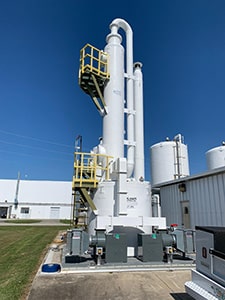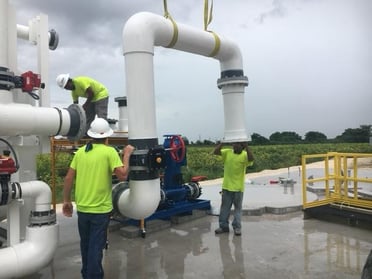
CO2 & pH In municipal and industrial water processes
Carbon Dioxide (CO2) in municipal and Industrial water can create problems in the water treatment process, increase operational costs of the treatment plant, and cause excessive corrosion to equipment and ancillary equipment.
In nature, one of the most natural common causes that create low pH or acidity in water is an element known as “Carbon Dioxide” (CO2). The process of how carbon dioxide enters the water in the first place is a topic worth exploring. Nature creates one of the most common causes of CO2 found in the water naturally. When the water reaches an equilibrium with our atmosphere followed by the biological degradation that is aided by the photosynthesis of organic carbon (CH2O) then carbon dioxide begins to form. Organic carbon is dissolved in water and it forms “Carbonic Acid”
(H2CO3). CO2 (g) + H2O (l) = H2CO3 (aq).
The process to form the carbonic acid is slow and only a small portion remains as an acid because proton losses occur during the process.
H2CO3 (aq) « H+ (aq) + HCO3- (aq)
CO3- (aq) « H+ (aq) + CO32- (aq)
To calculate the acid equilibrium the equations can be calculated to provide the fraction of carbonates in a particular form when understanding the concentrations in water.
In nature, aqueous CO2 can undergo various inorganic equilibriums as well like when it encounters limestone. Carbon dioxide in aqueous form will dissolve limestone and increase levels of dissolved calcium and calcium carbonate (CaCO3) in the water. The reaction looks like this:
CaCO3 + CO2 (aq) + H2O « Ca2+(aq) + 2 HCO3- (aq)
In municipal and industrial water applications the water pH is often lowered by adding acid as part of the treatment process to either prevent scaling or to liberate other gases such as Hydrogen Sulfide (H2S). When removing Hydrogen Sulfide (H2S) the pH can be lowered to its optimum range of 5 for maximum conversion of the sulfides to allow removal. Once the hydrogen sulfide is removed the pH can be raised back to a neutral state of 7 and the most economical method to raise the pH is through a process called “Decarbonation”. In order to select and size the decarbonator or degasification tower we must first calculate the amount of CO2 dissolved in water under an atmosphere of pressure by applying and using Henry’s Law.
Decarbonization is a process through which carbon dioxide (CO2) is removed from the water. Based upon the atmosphere and vapor pressure of the contaminant being removed a value can be calculated with extreme accuracy for the amount or percentage of removal of a specific gas. In this case, the removal of carbon dioxide gas can be stripped through the use of the decarbonation process that utilizes fiberglass, aluminum, stainless steel, or even rubber-lined steel vertical forced draft tower. The equipment is referred to as a “decarbonator” or degasifier and consists of the vertical column round or square, a media bed, and a forced or induced type blower system. The result of the decarbonation process is a reduction of CO2 levels which is stripped and exhausted through the top of the tower. As the CO2 is liberated and removed from the water stream the carbonic acid levels drop and this causes the rise of the water’s pH level. The descriptions- “Decarbonation” and “Degasification” are used synonymously with all forms of water filtration treatment and with high-purity water treatment. Decarbonators are available as “forced draft or Induced draft” type designs and also come in round or square configurations. Decarbonators can be produced with 6061 aluminum material or Fiberglass material.
How decarbonization works!
The majority of atmospheric gasses are comprised of nitrogen, oxygen, and carbon dioxide. Per Henry’s Law of gas solubility, water contains these gasses in solution form. However, as an exception to this law, carbon dioxide reacts with the water, forming carbonic acid, effectively lowering the pH of the water after ionizing it into hydrogen and bicarbonate ions.
Water quality specifications demand that water should exhibit a resistivity of 10 megohms or higher. The hydrogen and bicarbonate ions lower this resistivity considerably. A decarbonator provides the means through which you can atomize the water, effectively increasing its surface area while passing air through it. This air has a relatively low pressure by atmospheric concentration in relation to the pressure of the CO2 in the water. In agreement with Henry's law, the CO2 is liberated from the water. The same principle can be applied either upstream or downstream with relatively similar results.

What are the benefits of decarbonization?
There are multiple benefits to removing CO2 through the use of a decarbonator tower. One is to protect the life of Cation and Anion ion exchange media beds utilized during water softening processes. The other is to reduce the use or need to add Caustic to lower the pH of the product finish water which in turns lowers the operational cost while improving the water quality. Other benefits include:
- High-quality water treatment
- Lower operational costs
- Reduction in corrosion of downstream equipment
- Easy installation and operation
- Durability
- Insensitivity to sedimentation
- Highly reliable
- Easier management and upkeep
Conclusion
Decarbonators are the most cost-effective method to remove and strip the CO2 from a water process to protect equipment, lower operating costs, prevent corrosion, and raise the pH of the water. The experienced staff and trained engineers at DeLoach Industries Inc can assist in design support to meet the most stringent needs. When designed and sized properly a decarbonator can raise the pH of water by 1 to 1.5 units from its current state. For more information or to learn more contact the professionals at DeLoach Industries Inc. at (941) 371-4995.
Related Blog: How Degasification Can Solve Your Water Treatment Issues




